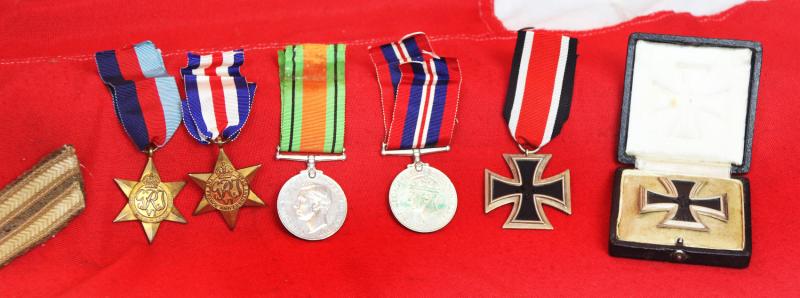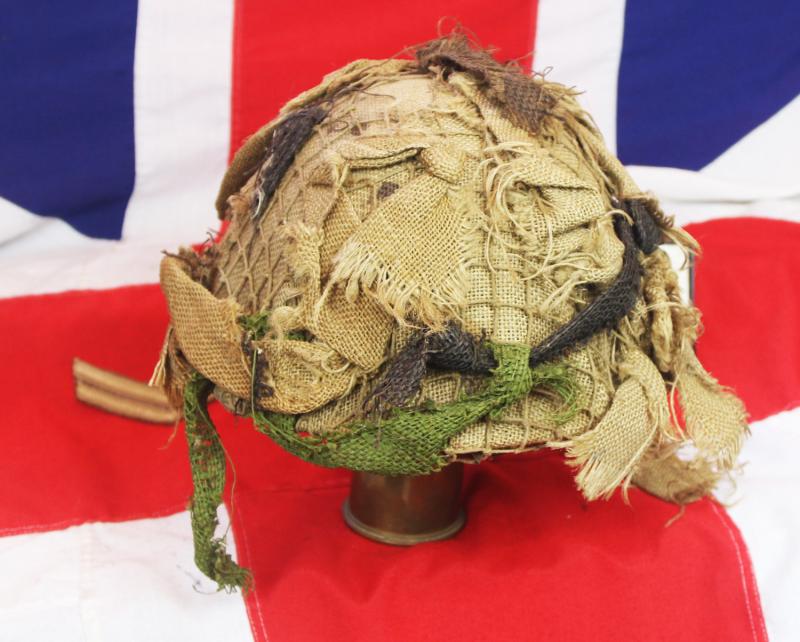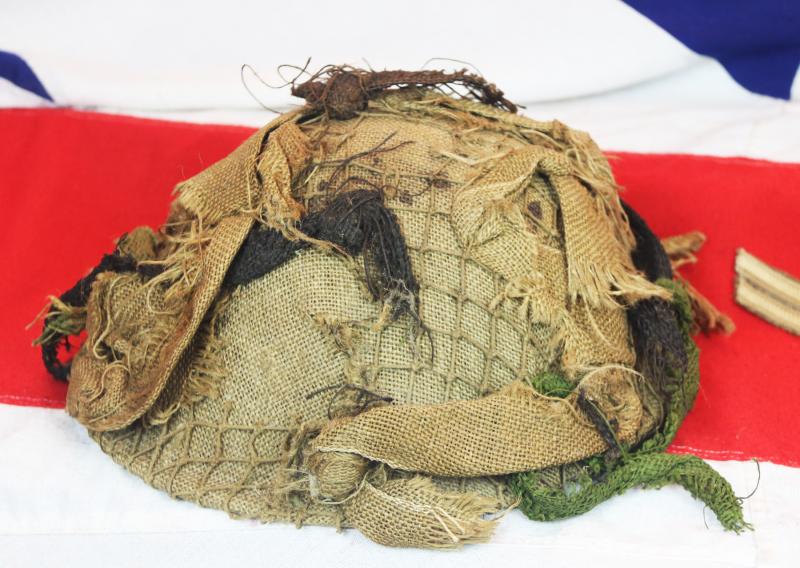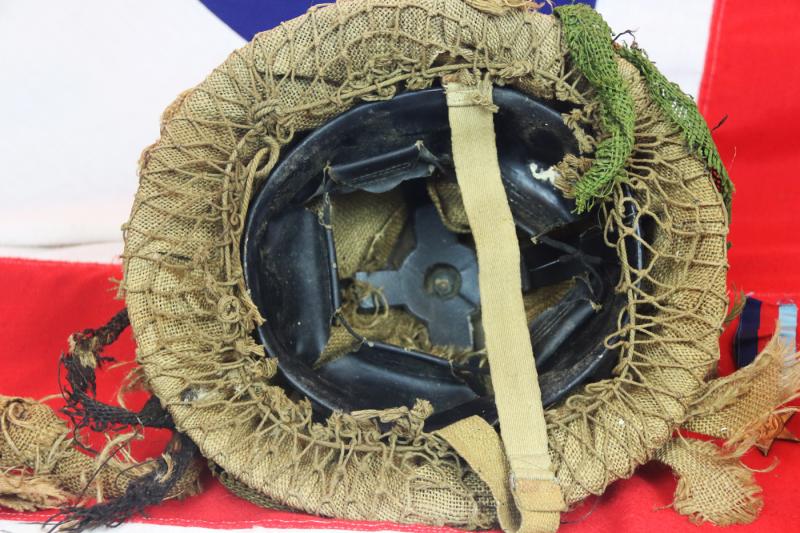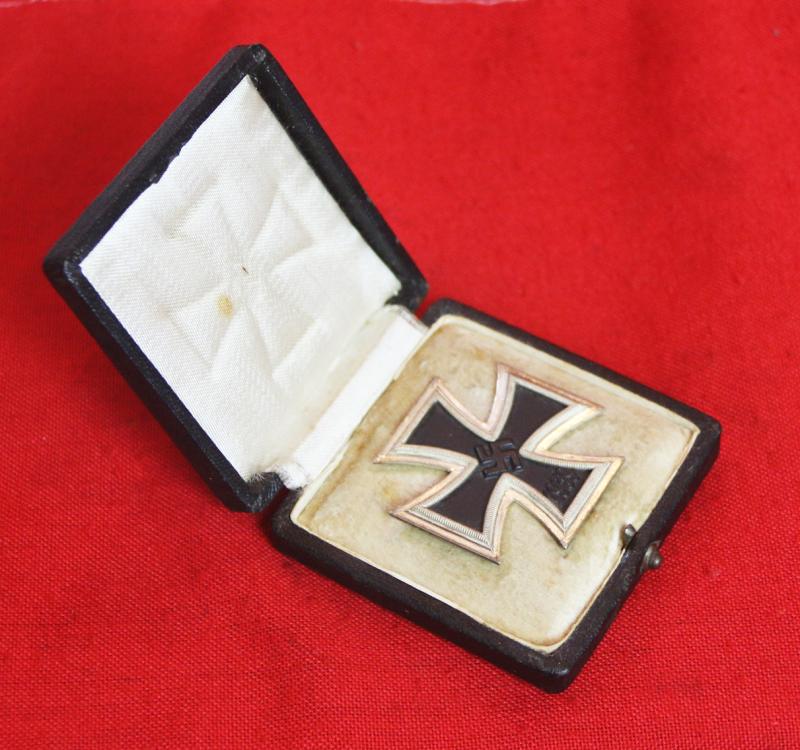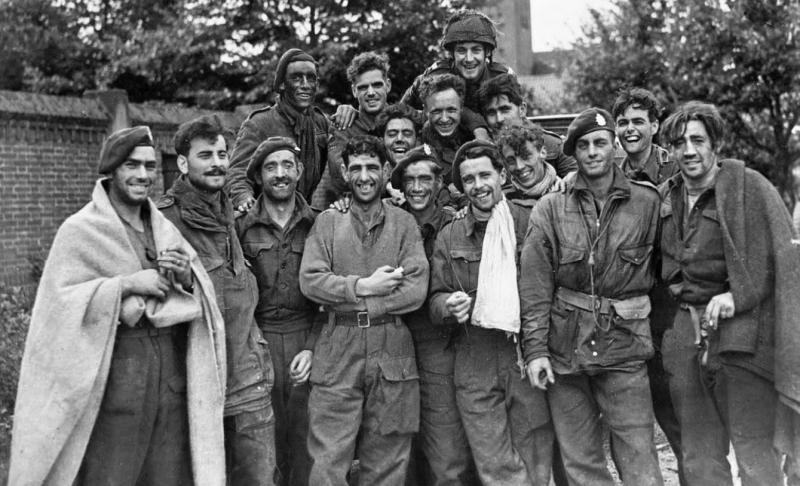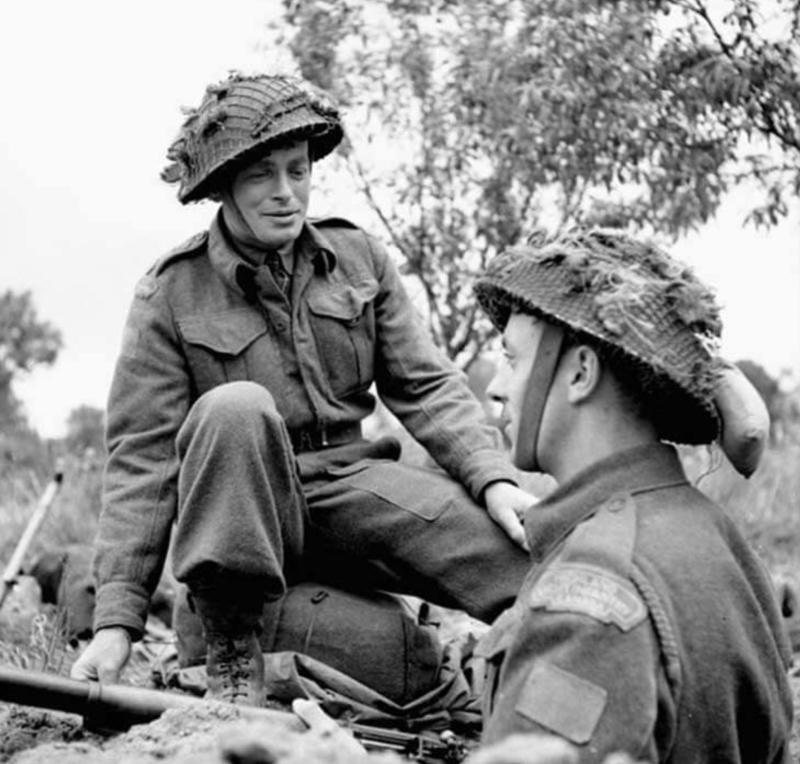Fabulous D-Day Collection, Medals, & Stripes, of ANCO Corporal of The Ox & Bucks Light Infantry & Later Part of the Airborne Div, Plus, An Original, Net Camouflaged, D.Day Pattern MK III 'High Rivet' Helmet.
The collection comprises group of his four British medals {unworn}, his German souvenirs of a near mint Iron Cross Ist Class in its original box, plus an Iron cross 2nd class, also near mint. Plus a D-Day Pattern MKIII high rivet helmet, with original netting and camouflaging, and his corporal's battledress stripes. The helmet may have painted regimental markings, but there is no way the net and camouflage should be removed in order to check. The German part of the collection, of the iron cross medals was sold separately.
We do not know if he qualified for more than his four medals, as his family knew not either. His German souvenir medals were put away after the war and never saw the light of day till very recently, which is why they are in superb condition. The helmet was not his original service issue, but it has been put with his collection. The German medals {which may be from an Arnham based SS Panzer Division} will be sold separately, but only his medals, stripes and D-Day MKIII camouflage helmet are sold together here under this stock code.
The Oxfordshire and Buckinghamshire Light Infantry committed three battalions to the Normandy campaign in 1944, with two landing on the 6th June 1944 - one by air, one by sea.
2nd Battalion (52nd), Oxfordshire & Buckinghamshire Light Infantry, 6th Airlanding Brigade, 6th Airborne Division
Part of 6th Airborne Division, 2nd Battalion were some of the first Allied troops to arrive in Normandy when six gliders carrying D Company and elements of B Company, led by Major John Howard, landed in the early hours of 6 June. Though one of the gliders landed some distance to the east, five would land remarkably close to their objective. They successfully captured and held the River Orne and Caen Canal bridges, securing a vital bridgehead to pave the way for the advance of the allied forces that would land on the beaches. One of these bridges was renamed Pegasus Bridge after the emblem of the British Airborne, the name it is still known by today. The rest of the Battalion would arrive by glider around 9pm on 6 June, landing at the bridgehead as part of Operation Mallard.
1st Buckinghamshire Battalion, Oxfordshire & Buckinghamshire Light Infantry, No. 6 Beach Group
The 1st Bucks Battalion, a territorial army battalion of the Ox & Bucks, also landed at Sword Beach on D-Day. Part of No. 6 Beach Group, an anti-tank platoon landed with the first tide, while the remainder landed with the second tide of the invasion force. The Group was responsible for organising units landing on Sword and arranging supply dumps in the area. As infantry support for the Beach Group, 1st Bucks were tasked with defending the beachhead from any counterattacks.
The Battle of Arnhem and the subsequent defence of the Oosterbeek Perimeter have passed into legend and the subject of numerous books and films, meaning that the story of the Operation is quite well known by most who have an interest in military history, what is probably less known is the contribution of the Regiment in Operation Market Garden.
Operation “Market Garden”
“Market” was the Airborne element of the operation, with three Allied Airborne Divisions being dropped behind enemy lines in Holland with the task of capturing and holding until relieved by ground forces, all the bridges along a “corridor” from the Belgian/Dutch border along a single road to the river Rhine at Arnhem.
The American 101st Airborne Division were to capture the bridges around Eindhoven, the American 82nd Airborne Division the bridges around Nijmegen and the British 1st Airborne Division along with the Polish Independent Parachute Brigade the bridges at Arnhem on the Rhine.
“Garden” was the land based element with the main thrust along the “corridor” being made by Lieutenant General Brian Horrocks’s British 30th Corps, with the 12th and 8th Corps on each flank. 30th Corps objective was to advance along the corridor linking up with the Airborne Divisions and reaching the Rhine at Arnhem within four days! From there the British 2nd Army could then cross the River Rhine, the last natural barrier, and then turn into the Ruhr and Germany itself and end the war by the end of 1944.
“This is a tale you will tell your grandchildren... …and mightily bored they’ll be”
Lieutenant General Brian Horrocks, commanding British 30th Corps
1st Battalion (43rd) Oxfordshire & Buckinghamshire Light Infantry
Operations by the 53rd (Welsh) Division in 12th Corps, containing the 43rd, aimed to protect the left flank of the land based “Garden” force, 30th Corps, pushing through the airborne corridor from Eindhoven to link up with the Market forces at Arnhem.
On 20 September the enemy withdrew through De Kruisberg, leaving a small force to cover the retreat. The 43rd followed at night to push ahead in single file through the town to protect the flank of 15th (Scottish) Division forming a bridgehead on the Wilhelmina Canal at Best.
The advance by the 43rd in the direction of Oirschot attracted heavy fire. The blown bridge at Oirschot was reached at midday on 21st and the nearside bank of the canal was made secure to protect the western flank of the Scottish Division. The canal was a formidable obstacle but could be crossed by wading infantry.
The village of Dun was captured and where Regimental Headquarters was established until 5 October.
Nijmegen, Holland - October 1944
On 5 October, the 43rd was ordered to move up to Nijmegen bridgehead as reserve battalion. The move was full of small incidents of enemy action and manoeuvre. The Battalion led the attack by 71st Brigade to liberate 's-Hertogenbosch, which was secured by 27th, but the remnants of the enemy did not withdraw completely over the Maas to the north.
The objectives of the 1st British Airborne Division were to capture and hold the bridges over the river Rhine at Arnhem, however in the end only a force slightly over battalion strength managed to reach and hold the northern approaches to the Road Bridge. Only the Second Parachute Battalion (less C company, who were separated in the town), reinforced by part of 1st Parachute Brigade HQ, individual members of 1st and 3rd Parachute Battalions and some attached arms personnel actually reached the Divisional objective – the Bridge.
The Corporal of the Oxford and Bucks Light Infantry Defence Platoon, survived the debacle, escaped capture during the greater Operation Market Garden, to be evacuated.. See a photo of some of the men evacuated {but not our Ox and Bucks combatant} in the gallery.
**The price shown is for the helmet, british campaign medals and stripes, it does not include the German medals, that were for sale, though now sold, separately.
The corporals name will be past on to the next owner.
Code: 25378
1150.00 GBP


